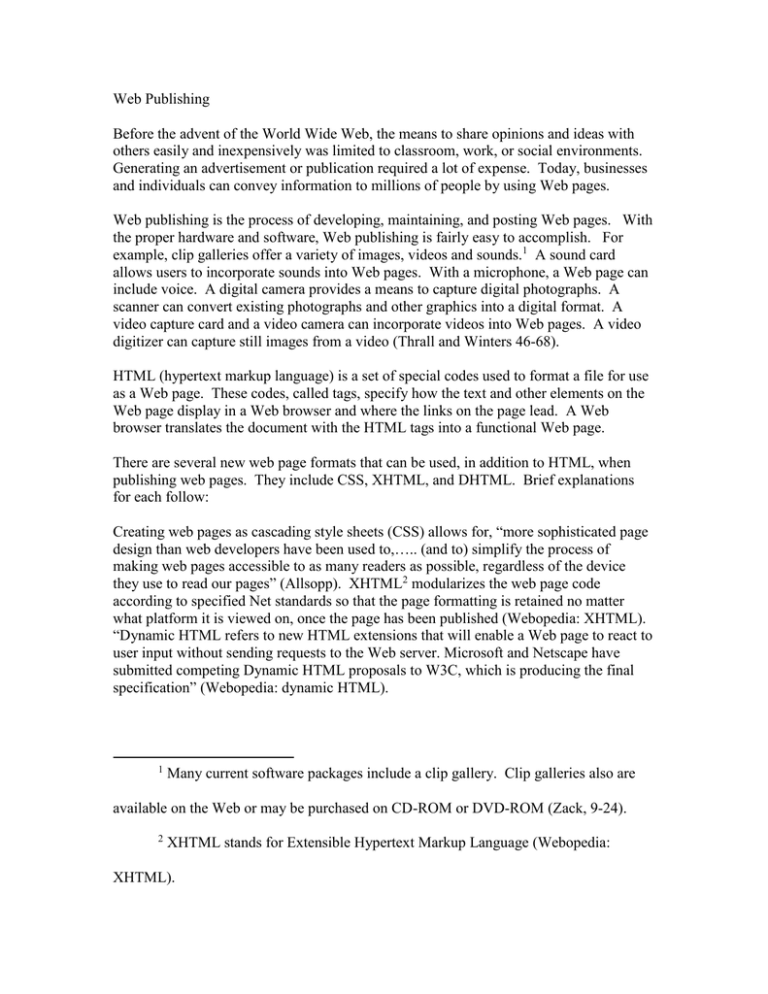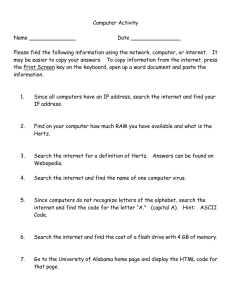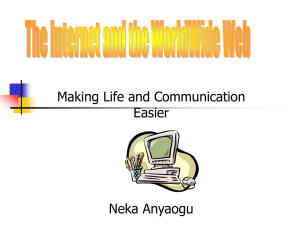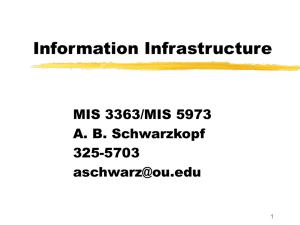Web Publishing
advertisement

Web Publishing Before the advent of the World Wide Web, the means to share opinions and ideas with others easily and inexpensively was limited to classroom, work, or social environments. Generating an advertisement or publication required a lot of expense. Today, businesses and individuals can convey information to millions of people by using Web pages. Web publishing is the process of developing, maintaining, and posting Web pages. With the proper hardware and software, Web publishing is fairly easy to accomplish. For example, clip galleries offer a variety of images, videos and sounds.1 A sound card allows users to incorporate sounds into Web pages. With a microphone, a Web page can include voice. A digital camera provides a means to capture digital photographs. A scanner can convert existing photographs and other graphics into a digital format. A video capture card and a video camera can incorporate videos into Web pages. A video digitizer can capture still images from a video (Thrall and Winters 46-68). HTML (hypertext markup language) is a set of special codes used to format a file for use as a Web page. These codes, called tags, specify how the text and other elements on the Web page display in a Web browser and where the links on the page lead. A Web browser translates the document with the HTML tags into a functional Web page. There are several new web page formats that can be used, in addition to HTML, when publishing web pages. They include CSS, XHTML, and DHTML. Brief explanations for each follow: Creating web pages as cascading style sheets (CSS) allows for, “more sophisticated page design than web developers have been used to,….. (and to) simplify the process of making web pages accessible to as many readers as possible, regardless of the device they use to read our pages” (Allsopp). XHTML2 modularizes the web page code according to specified Net standards so that the page formatting is retained no matter what platform it is viewed on, once the page has been published (Webopedia: XHTML). “Dynamic HTML refers to new HTML extensions that will enable a Web page to react to user input without sending requests to the Web server. Microsoft and Netscape have submitted competing Dynamic HTML proposals to W3C, which is producing the final specification” (Webopedia: dynamic HTML). 1 Many current software packages include a clip gallery. Clip galleries also are available on the Web or may be purchased on CD-ROM or DVD-ROM (Zack, 9-24). 2 XHTML stands for Extensible Hypertext Markup Language (Webopedia: XHTML). Developing, or authoring, a Web page does not require the expertise of a computer programmer. Many word processing and other application software packages include Web page authoring features that assist in the development of basic Web pages. Microsoft Office 2000 products, for example, provide easy to use tools that enable users to create Web pages and incorporate items such as bullets, frames, backgrounds, lines, database tables, worksheets, and graphics into the Web pages (Shelley Cashman series ® Microsoft Word 2000 Project 2). Web page authoring software packages enable the development of more sophisticated Web pages that might include video, sound, animation, and other special effects. Both new and experienced users can create fascinating Web sites with Web page authoring software. Conclusion In today’s world a person can distribute a message, product or service, to any other person who might be interested, around the world. This can be accomplished quickly and easily by publishing a web page on the Internet. Web pages can be much cheaper to produce than printed publications, can reach a far wider audience, and can incorporate a variety of text, images, video, and sound objects. Another important advantage of web publishing is that pages can be changed and updated more frequently than printed materials. Also, by using web page authoring software, the average person can generally create a web page without a thorough understanding of the programming code. If you have a message that you would like to share with a global audience, web publishing just might be the answer for you. Works Cited Thrall, Peter D., and Amy P. Winters. Computer Concepts for the New Millennium. Boston. International Press, 2001. Zack, Joseph R. “An Introduction to Clip Galleries and Digital Files.” Computers for Today, Tomorrow, and Beyond Sep. 2001: 9-24. Shelley Cashman Series ® Microsoft Word 2000 Project 2. Course Technology. 2000: WD 2.5. Allsopp, John. “Cascading Style Sheets Reference: Everything You Wanted to Know About Style.” The House of Style. http://www.westciv.com/style_master/academy/css_tutorial/index.html (October 13, 2000). “XHTML.” Webopedia: Online Computer Dictionary for Internet Terms and Technical Support. http://webopedia.internet.com/TERM/X/XHTML.html (October 13, 2000). “dynamic HTML.” Webopedia: Online Computer Dictionary for Internet Terms and Technical Support. http://webopedia.internet.com/TERM/d/dynamic_HTML.html (October 13, 2000).





